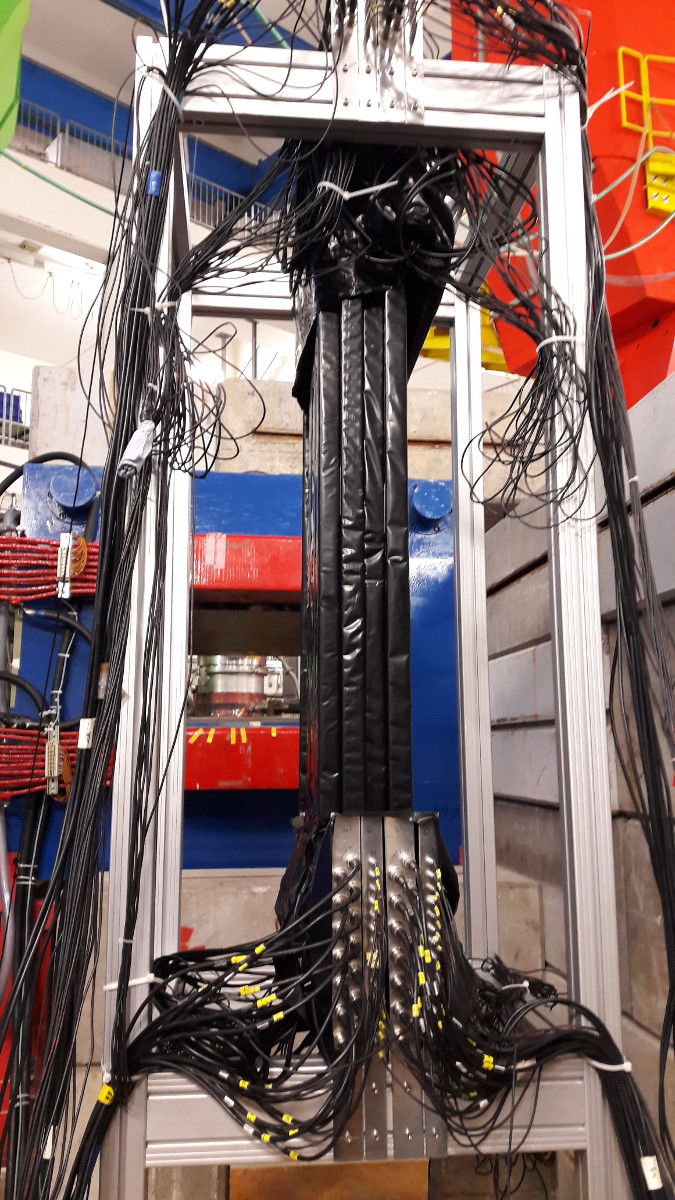 There are two new setups for the central trigger system available, both based on a Trb3sc:
There are two new setups for the central trigger system available, both based on a Trb3sc:
a stand-alone version with 20 TDC channels that allows a fully independent read-out system for one Padiwa board. A 32 channel version might be available on request. One SFP allows to connect further front-end boards.
a CTS to connect up to 8 front-ends boards. This requires a SFP-AddOn-v2 and an adapter board with 9 RJ connectors (shown in the photo). The front-ends can be connected directly with an optical fiber and one RJ-45 cable - no additional fan-out for the reference time is needed. It allows provides two inputs on each RJ connector to feed back trigger signals from the front-ends to the CTS.

A segmented Fast Light Acquiring Start Hodoscope
(FLASH) prototype was constructed and tested at the Mainz Microtron
(MAMI). Its working principle is based on the detection of Cherenkov
light, produced inside radiator bars made of synthetic fused silica, by
fast Micro-Channel Plate PMTs (MCP-PMTs). The bars are inclined with
respect to the particle trajectory to match the Cherenkov angle to
mininmize reflections off the radiator surfaces.
The segmentation allows determining a coarse impact position (~few mm) and also repeatedly measuring the arrival time so
that an averaging procedure can be used to improve the timing precision.
The FLASH protoype is built around the PLANACON
64-channel MCP-PMT with a pore size of 10 micron. The radiator bars (5 x
5.5 x 140 mm^3) are arranged in an 8 x 8 matrix so that each radiator
bar matches a pixel on the MCP-PMT. The MCP-PMTs are equipped with
NINO-based frontend electronics providing leading edge time and
Time-over-Threshold (ToT). The frontend electronics is read out with
modified TRB boards where the DC/DC converters were taken off.
Two such units were tested using the 855 MeV
electron beam of MAMI. The detector response was investigated and the
basic characteristics were extracted. The timing performance was studied and
the ToT information was used to perform walk corrections. The best
timing precision achieved was ~50 ps per FLASH unit. The results are also published here:
http://dx.doi.org/10.1016/j.nima.2017.02.080

A prototype of the A1 Neutron Detector comprising 24 plastic scintillator bars and four plastic scintillator veto panels was tested in the Three-Spectrometer-Hall at the Mainz Microtron (MAMI). Each scintillator bar or veto strip is instrumented with two PMTs enabling position reconstruction along the bar axis via timing between the two PMTs. Furthermore, Time-over-Threshold (ToT) information is used to suppress background from charged particles. In addition, very high rates per scintillator (~MHz) are expected for the final experiment.
The PMT signals are send to NINO frontend boards which, in turn, are read out by a TRB system. Using the CBM-MBS external trigger module the A1 trigger number is also included in the data stream.
All of these requirements were successfully tested during the recent test beam time in Mainz.

Thanks to the effort of Jennifer Wettig (Universität Mainz), the TRB collaboration now has its own logo, containing puzzle pieces as a symbol for all our different components of software and hardware playing together to form an extensive data acquisition environment.
The new Website trb.gsi.de in a new look has been launched. Thanks to Jan for the all the work. Looks good!
 There are two new setups for the central trigger system available, both based on a Trb3sc:
There are two new setups for the central trigger system available, both based on a Trb3sc:




